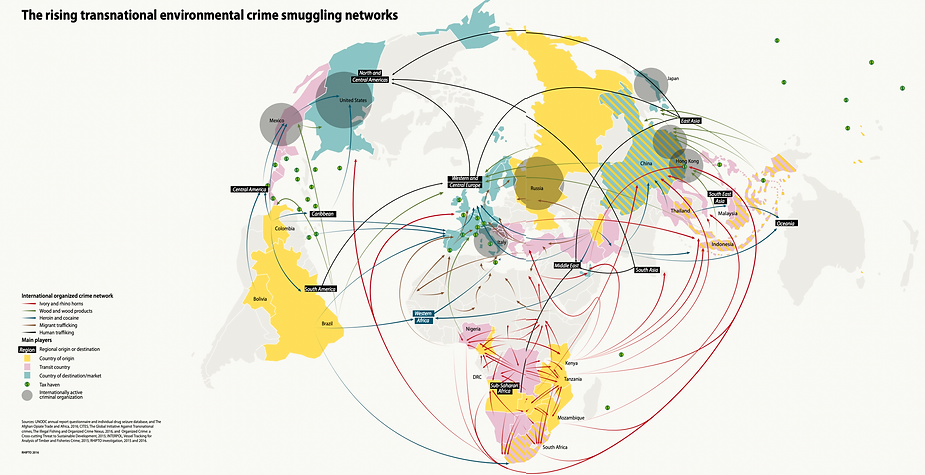In a world that thrives on globalization and interconnectedness, trade has become the lifeblood of nations and the backbone of economies. Legitimate commerce channels goods, services, and ideas across borders, fostering prosperity and cultural exchange. However, intertwined with the legitimate flows of goods and services are the clandestine corridors of illicit trade, hidden from view but exerting a profound influence on international trade regulations.
There are over a thousand smuggling routes worldwide, facilitating the illicit movement of goods and services associated with environmental crimes, drugs, and human trafficking. In today’s world, we witness an unprecedented scale of funding for conflicts and acts of terrorism, primarily sourced from transnational organized crime and the revenue generated through the illicit exploitation of natural resources.
While it remains challenging to precisely determine the value of revenues flowing to criminalized groups and non-state armed organizations, a rough estimate can be shared by focusing on the significant non-state armed groups. Notably, environmental crime, which encompasses activities such as wildlife trafficking, fuel smuggling, and the illicit extraction of valuable minerals like gold and diamonds, has emerged as the single largest source of income for non-state armed groups and terrorist organizations. Collectively, environmental crimes, including those linked to the sale and taxation of natural resources, account for 38% of the financing that sustains conflicts and non-state armed groups, including terrorist entities. This is followed by drug-related activities, constituting 28% of the funding, while other forms of illegal taxation, extortion, confiscation, and looting contribute 26%. External donations and money acquired through kidnapping comprise 3% of the funding.
Some of the well-known regions and trade routes associated with illegal activities:

- Golden Triangle: The Golden Triangle, located in Southeast Asia, where the borders of Myanmar, Laos, and Thailand converge, is infamous for its history of opium and heroin production. It has been a major source of illegal drug trafficking.
- Golden Crescent: The Golden Crescent region, which includes parts of Afghanistan, Pakistan, and Iran, is a significant producer of illicit opium and heroin. Afghanistan, in particular, is known for being the world’s largest opium producer.
- South American Drug Routes: Various routes run through South America, including the Andean region and the Amazon Basin. These routes are associated with the production and trafficking of cocaine and other illicit drugs.
- West African Coast: The Gulf of Guinea and the West African coast are notorious for various illegal activities, including drug trafficking, oil smuggling, and piracy. These activities have posed significant challenges to regional security and stability.
- Somalia Coast: The waters off the coast of Somalia have been plagued by piracy, particularly in the Gulf of Aden and the Indian Ocean. Pirates often target commercial vessels and demand ransoms for the release of crew and cargo.
- Strait of Hormuz: This narrow waterway between Iran and the Arabian Peninsula is critical for global oil transportation. It has been a site of geopolitical tensions and occasionally sees illegal activities such as smuggling and sanctions evasion.
- South China Sea: The South China Sea is a hotbed of territorial disputes and has seen various forms of illegal trade, including illegal fishing, oil theft, and smuggling.
- Trans-Saharan Routes: The Sahel region in North Africa has been associated with various illicit activities, including arms trafficking, human smuggling, and drug trafficking.
- Balkan Route: This historic route through the Balkans has been used for various illegal activities, including human trafficking, arms smuggling, and drug trafficking.
Next time, watch out for such shipping red flag indicators during your export control transactions!



